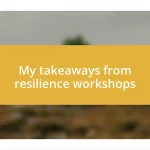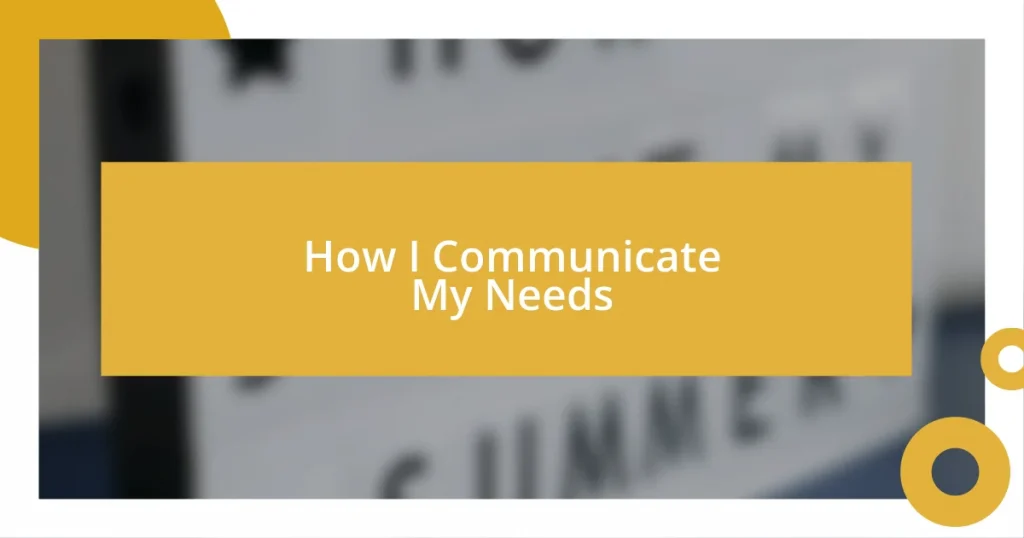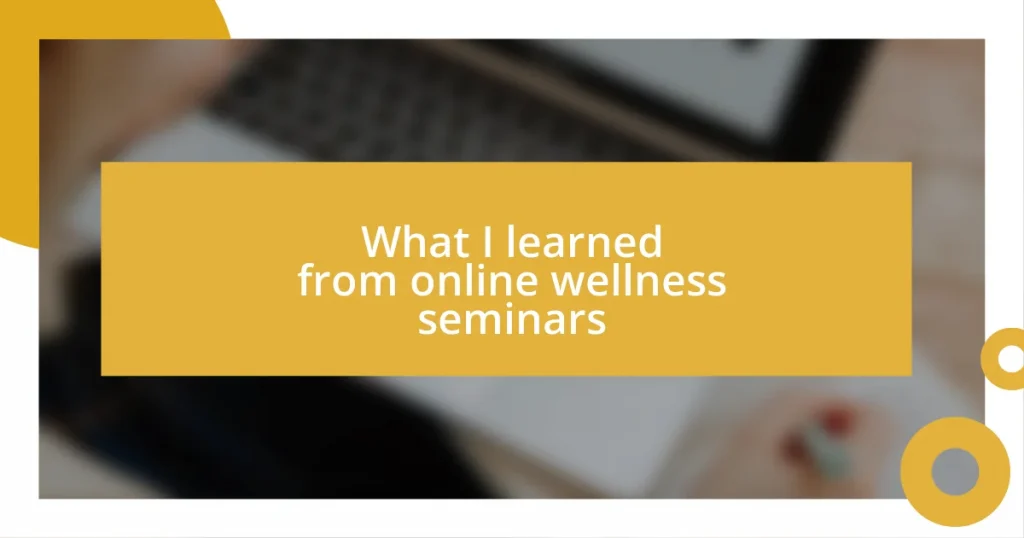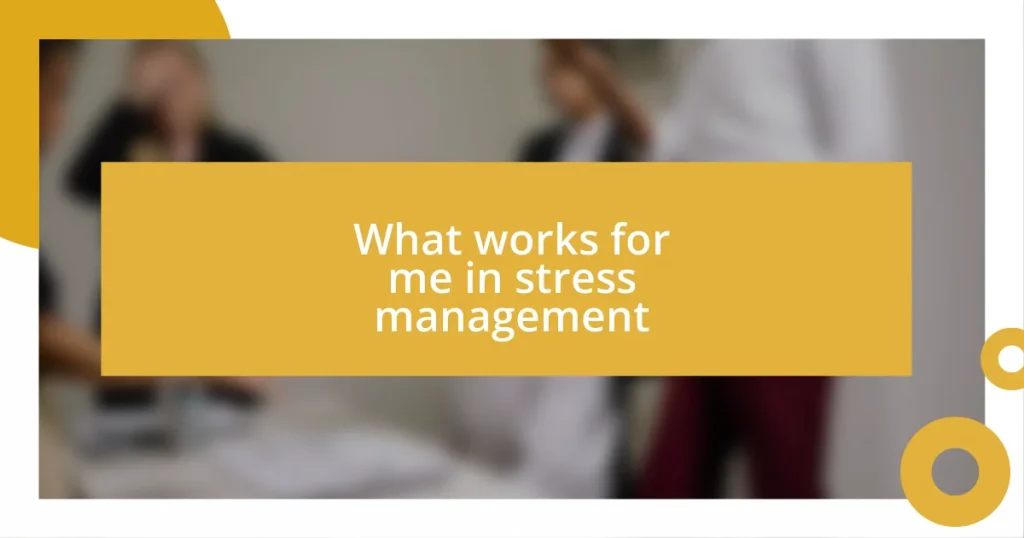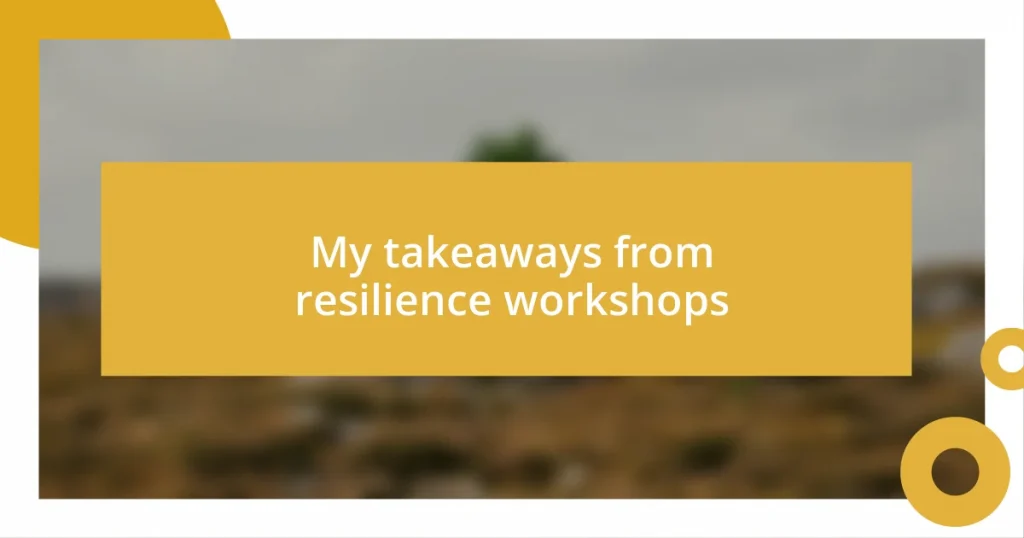Key takeaways:
- Understanding personal needs involves self-reflection and recognizing emotional undercurrents that drive our desires for connection and validation.
- Effective communication requires awareness of our styles (assertive, passive, aggressive) and using clear, specific language to convey our needs, fostering trust and clarity.
- Navigating difficult conversations and practicing self-advocacy can be enhanced through preparation, empathy, and being assertive about personal boundaries and responsibilities.

Understanding Personal Needs
Understanding personal needs is an ongoing journey, often filled with revelation. I remember a time when I felt a nagging sense of discontent, realizing that my need for approval was overshadowing my own desires. Have you ever felt that way, where the opinions of others shape your decisions more than you’d like?
It can be eye-opening to recognize that our needs aren’t always obvious. One weekend, while reflecting during a quiet moment, I discovered that I craved connection more than I thought. This insight made me ponder: how often do we ignore the simplest, yet most fundamental needs in our lives?
Recognizing personal needs often requires deep self-reflection and vulnerability. I recall a conversation with a close friend where I admitted my fear of not being heard. In that moment, I realized my need for validation from those I hold dear was more potent than I’d acknowledged. Have you taken the time to explore what truly makes you feel valued? Understanding these emotional undercurrents is key to effectively communicating our needs.

Identifying Communication Styles
Identifying our communication styles is crucial for expressing our needs effectively. I vividly remember a workshop I attended where we explored different styles, like assertive, passive, and aggressive communication. Realizing I often leaned towards a passive style was enlightening; it made me aware that avoiding confrontation left my needs unexpressed, creating frustration instead of clarity.
Understanding your own communication style can facilitate better interactions. Here are some key characteristics to help you identify your style:
- Assertive: Clearly expresses thoughts and needs while respecting others.
- Passive: Avoids expressing feelings, often leading to unmet needs.
- Aggressive: Conveys needs but may disregard others’ feelings, causing conflict.
- Passive-Aggressive: Indirectly expresses dissatisfaction, often masking true feelings.
- Submissive: Puts others before oneself, often neglecting personal needs.
This awareness allows us to engage in more meaningful conversations, ensuring that our needs are not just recognized but also communicated clearly.

Using Clear Language Effectively
Using clear language is an art that transforms how we communicate our needs. I remember a time when I asked a colleague for help on a project but did so in a roundabout way. Instead of directly stating what I needed, I used vague terms, and as a result, my colleague was confused. I’ve learned that specificity helps bridge gaps in understanding, making our expectations transparent.
When expressing needs, simplicity is key. I recall a moment during a family gathering when I wanted everyone to engage more in conversation. Instead of saying, “Let’s talk,” I suggested, “Can we each share one highlight from our week?” This clear request not only prompted interaction but also set a comfortable tone for sharing. It’s fascinating how small adjustments in the wording can yield significant changes in our interactions.
In my experience, clear language also builds trust. I once faced a challenging situation with a friend who was constantly late to meetups. Rather than masking my feelings in diplomatic phrases, I said, “I feel worried when you don’t show up because I value our time together.” This openness fostered understanding and strengthened our relationship. The right words can not only convey our needs but also invite others to respond with empathy.
| Clear Language | Vague Language |
|---|---|
| Specific and direct requests lead to clarity. | Ambiguous terms lead to confusion. |
| Using simple words fosters understanding. | Complex language can alienate listeners. |
| Honest expression builds trust and connection. | Indirect communication can breed misunderstanding. |

Practicing Active Listening Techniques
Practicing active listening techniques is a game changer in how we connect with others. I recall a situation where a friend shared a personal challenge, and instead of jumping in with my own advice, I focused entirely on her words. By summarizing what she said—“So, you’re feeling overwhelmed at work and unsure how to manage it all?”—I noticed her shoulders relaxed as she felt truly heard. Isn’t it incredible how a simple reflection can create such a safe space for someone to express their feelings?
Being fully present when someone speaks is crucial, and that means eliminating distractions. I remember attending a meeting where everyone was glued to their devices. Rather than engage, I decided to put my phone away and give my full attention to the speaker. Strangely, the energy shifted; others started to follow suit. Have you ever noticed how just being present can elevate the quality of conversations? It’s like opening a door to deeper connections.
Another powerful technique I’ve learned is to ask open-ended questions. I once had a friend who was hesitant to share her thoughts, so instead of asking, “Are you okay?” I asked, “What’s been on your mind lately?” This small shift in questioning opened the floodgates for an honest dialogue. Feedback like this not only shows genuine interest but also encourages others to dig deeper. In my experience, active listening transforms a simple exchange into a meaningful conversation—one that can foster understanding and strengthen relationships.

Setting Boundaries Confidently
Establishing boundaries confidently requires self-awareness and clarity about what we truly need. I remember a time when a friend continuously borrowed my things without asking. After some initial hesitance, I finally gathered the nerve to say, “I need you to ask me before taking my belongings.” It was such a relief to communicate my limits clearly. The feeling of being true to myself and having my needs seen was empowering.
When I think about the nuance of boundary-setting, it strikes me how much it can influence our relationships. I once felt overwhelmed by invitations that didn’t align with my schedule. Instead of simply declining, I chose to express that I was focusing on my personal projects. Saying, “I’d love to join, but I need some time for myself right now” made a big difference; not only did it convey my needs, but it also kept the door open for future invitations. Have you ever experienced how simply expressing your truth can reshape a situation dramatically?
The more I practice setting boundaries, the more I realize it’s about mutual respect. Recently, I had a colleague frequently interrupt me in meetings. One day, I said, “I appreciate your enthusiasm, but I would really like the chance to finish my thoughts.” It was a straightforward moment, but it transformed the dynamic in our discussions. This simple action not only helped my voice be heard but also encouraged a culture of respect and listening. What might your experience be if you approached boundary-setting with the same confidence?

Navigating Difficult Conversations
Navigating difficult conversations often feels daunting, but I’ve found that preparation can help ease the anxiety. I recall a time when I had to discuss a sensitive issue with a team member. By jotting down key points in advance, I noticed I felt more grounded and focused during our chat. Does writing down our thoughts transform what could be an emotional free-for-all into a more structured dialogue? Absolutely!
Another strategy I’ve leaned on is practicing empathy. There was a moment when a close friend reacted sharply to my feedback. Rather than getting defensive, I took a step back and asked, “What part of my words troubled you?” This not only opened the door for her to share her feelings, but it also helped me understand her perspective better. Have you noticed how tapping into empathy can reshape a challenging conversation? It creates a bridge of understanding rather than a barrier.
I’ve also learned the importance of timing. For instance, I once approached my partner with a concern after a long day, and it didn’t go well. I realized later that the moment had been all wrong—he was exhausted and not ready to engage. This taught me to assess whether the time is right before diving into tough discussions. How many times have you experienced the impact of choosing the right moment? The difference can be monumental in fostering productive dialogue.

Practicing Self-Advocacy Skills

Practicing Self-Advocacy Skills
When it comes to advocating for my own needs, I’ve realized that clarity plays a critical role. I remember a time when I was struggling with a workload that felt insurmountable. Instead of just working harder, I approached my supervisor and said, “I’m feeling overwhelmed by my tasks. Can we discuss a possible redistribution of responsibilities?” That conversation not only lightened my load but also opened up a dialogue about team support—something I hadn’t anticipated but truly valued.
Another lesson I’ve learned is the power of assertiveness in self-advocacy. In a chat with a friend, I once expressed my need for more honesty. “I appreciate our friendship, but sometimes I feel like you’re not being upfront with me,” I said. It felt vulnerable, yet I watched as our relationship deepened following that moment of shared honesty. Isn’t it interesting how articulating our needs can lead to stronger bonds?
I also think about the importance of practicing in everyday scenarios. I’ve started saying “no” when necessary, even when it’s uncomfortable. The first few times felt stiff, like wearing a new pair of shoes. But with each instance, I felt a surge of confidence. “I need time for myself this weekend,” I’d say, and surprisingly, people respected that. Have you ever experienced that kind of personal growth? It’s as if every small act of self-advocacy strengthens a muscle we didn’t even realize we had.


